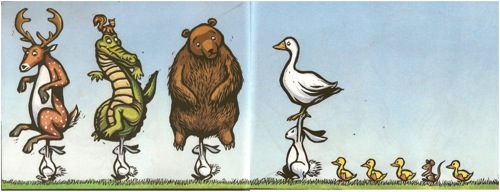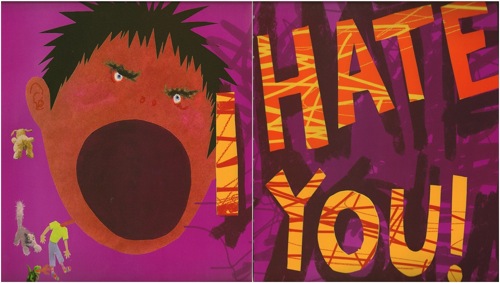by Prisca Martens, Towson University, Towson, MD
During September we have explored how learning to read mulitmodally by integrating the pictorial text with the written text in picturebooks relates to young children’s reading development. We’ve examined children’s responses to picturebooks when they learn to read multimodally and also discussed classroom experiences that support that learning/reading.
 This week I’ll share two picturebooks that we use regularly because they offer rich opportunities to talk about how artists represent meaning in the pictorial text. The first is My Friend Rabbit (Rohmann, 2002), the story of Mouse whose best friend Rabbit gets Mouse’s airplane stuck in a tree and has to figure out how to get it down.
This week I’ll share two picturebooks that we use regularly because they offer rich opportunities to talk about how artists represent meaning in the pictorial text. The first is My Friend Rabbit (Rohmann, 2002), the story of Mouse whose best friend Rabbit gets Mouse’s airplane stuck in a tree and has to figure out how to get it down.
The story has lots of action and Rohmann represents movement in different ways. One way is by repetition. For example, he uses dotted lines (repeated rectangular shapes) to show the airplane’s path and repeated parallel lines around an object to indicate it is moving or shaking. Rohmann also repeats the image/shape of Rabbit. Rabbit’s solution for retrieving the airplane is to make a stack of animals starting with the largest on the bottom. The plan is for him, Squirrel, and Mouse to get on the very top of the stack to reach the airplane. One page has four images of Rabbit, each time carrying a different animal, yet there is only one rabbit in the story. The children realize that by repeating images of Rabbit, Rohmann represents the movement/passage of time.
The plan is for him, Squirrel, and Mouse to get on the very top of the stack to reach the airplane. One page has four images of Rabbit, each time carrying a different animal, yet there is only one rabbit in the story. The children realize that by repeating images of Rabbit, Rohmann represents the movement/passage of time.
 The Day Leo Said I Hate You! (Harris, 2008; illustrated by Molly Bang) provides opportunities to talk about warm and cool colors, pointed lines and shapes, and size. In the story Leo gets angry when his mother repeatedly says “no” to his fun and he ends up screaming, “I hate you!” at her. While some artists use warm colors to show good and cool colors to show bad (i.e., Chen in Guji Guji), Molly Bang uses warm colors to show anger and cool colors to show calm. Contrasting books in which artists use color in different ways helps children realize that there is not only one way to represent meaning through color or any other aspect of art. Bang also uses pointed shapes (i.e., Leo’s hair) and enlarges Leo’s head to cover most of the page, with a small body, to emphasize Leo’s anger.
The Day Leo Said I Hate You! (Harris, 2008; illustrated by Molly Bang) provides opportunities to talk about warm and cool colors, pointed lines and shapes, and size. In the story Leo gets angry when his mother repeatedly says “no” to his fun and he ends up screaming, “I hate you!” at her. While some artists use warm colors to show good and cool colors to show bad (i.e., Chen in Guji Guji), Molly Bang uses warm colors to show anger and cool colors to show calm. Contrasting books in which artists use color in different ways helps children realize that there is not only one way to represent meaning through color or any other aspect of art. Bang also uses pointed shapes (i.e., Leo’s hair) and enlarges Leo’s head to cover most of the page, with a small body, to emphasize Leo’s anger.  When asked to look at the pictorial text in books like these and think about why the artist may have selected particular colors, lines, shapes, etc., for particular scenes or characters, the children look closely and generate solid reasons. We are less concerned with whether or not the students’ speculations are correct and more concerned that they understand that the illustrations are the result of a composing process and not merely finished objects.
When asked to look at the pictorial text in books like these and think about why the artist may have selected particular colors, lines, shapes, etc., for particular scenes or characters, the children look closely and generate solid reasons. We are less concerned with whether or not the students’ speculations are correct and more concerned that they understand that the illustrations are the result of a composing process and not merely finished objects.
I have appreciated the opportunity to share my current thinking and work. If you have any comments, I welcome them.
Arizpe, E., & Styles, M. (2003). Children reading pictures: Interpreting visual texts. New York:
RoutledgeFalmer.
Chen, C. (2004). Guji Guji. La Jolla, CA: Kane/Miller.
Harris, R. (2008). The day Leo said I hate you! Illus. by M. Bang. New York: Little Brown.
Rohmann, E. (2002). My friend rabbit. New York: Square Fish.
Journey through Worlds of Words during our open reading hours: Monday-Friday, 9 a.m. to 5 p.m. and Saturday, 9 a.m. to 1 p.m. To view our complete offerings of WOW Currents, please visit archival stream.
- Themes: pictoral text, picture books, Prisca Martens
- Descriptors: Books & Resources, Debates & Trends, Student Connections, WOW Currents

I have always seen the importance of illustrations in books because it creates a better understanding and sets the mood and scene better. I have had art class and we learned about cool and warm colors to express different emotions. It is awesome to use this technique in children’s books as well because even if they don’t understand the difference between warm and cool colors, the tone is still set for the story and impacts them whether they realize it or not. It’s also neat how illustrations can teach children about movement and the concept of time by the way the illustrator chooses to depict these items in their pictures. Illustrations in general are a great tool to grasp the reader’s attention and create a more lasting effect on them by relating to their visual sense of learning and understanding. I know I myself am a visual learner and have always preferred visual examples over written examples.
I think it is very important for children to be able to look at and understand illustrations in picture books. The pictures in books are a very important part of the story and more times than not the story is dependent on the pictrues to be able to make sense and to be of any interest of children today. I think colors are a very important part of a book also. It sets a mood throughout a story and can show feeling of the characters in the story. Also many students are visual learners and the pictures help them to better understand the story. Pictures are also important for children who are unable to read yet. The pictures are what draws them to books and they try to read them through the pictures.
I think picture books are always much better when they have great illustrations to go along with them. I took an art class last semester where we had to learn about how to create movement in pictures or how certain lines can make your eye look at an important part of the picture. I think using all these techniques in illustrations of childrens books is a good idea because that is the kids favorite part.
I think it is very important for children to understand illustrations in books. This is why I love picture books so much because there is so much more to them than the story itself.
Illustrations really help in telling a story. Many times children can figure out what a word is by looking at the pictures and using reasoning. They see the pictures and automatically relate with it in some way. I really like how the book “The day Leo Said I Hate You” used colors to portray a mood or emotion. It is a great way to introduce colors and emoitions. Shapes and lines can also bring about emotion ad flow of the story and a child can easily tell you. They often know the pace of the story by looking at the pictures and the point of focus. Without pictures, children would not be as interested in books and would not understand them as well. It is pictures that brings a children book to life!
I think children really do need to understand that illustrations in books are as big of a part of the story as the words. Sometimes the impact of a story would be lost without the pictures that come along with it. Illustrations are especially important for young children in helping them understand what is happening in a story. Learning to interpret movement and things in pictures are also good skills to have as a child and promote greater understanding.
Illustrations can be the most important part of a child’s picture book. Younger children, who may not be able to read it, can look at the pictures and tell their own story. This is a wonderful way to allow children to use their imaginations. I know my three year old cousin does this. She’ll look at the people in the illustrations and depending how they are dressed, their facial expression, and their surroundings, she is able to create a story from it.
I like how the book, The Day Leo Said I Hate You!, uses a variety of colors and lines to create movement and mood. The sharp and jagged angles, along with the coloring really allows you to feel his anger. I also liked how the size of the illustrations also created feeling. This book is a perfect example to show to children and teach them the art part of illustrations in children’s literature.
Illustrations are such a big part of a picture book! Even if a child can read, looking at pictures really helps. With younger children can even tell their own story by looking at the pictures themselves. A story just isn’t as fun and creative if there aren’t pictures to go along with it.
My Friend Rabbit was a 2003 Caldecott medal winner. This book has fantastic illustrations. I think that books like these grab young readers even if they do not have a love of reading. Illustrations are essential to enticing these young emerging readers to become lovers of reading. This book is not full of a lot of words. The story is very simple and makes your focus turn to the great illustrations. This is a great book for any young person in your life.
I think these two books are excellent ways to show how much the illustrations give the words more meaning. Good illustrations will grab the reader’s attention and really bring out the meaning(s) to the books. Children and adults alike can relate to many stories just by looking at the illustrations. Like in “The Day Leo Said I Hate You” I am sure we all have been frustrated and upset at one time or another and the illustrations help us relate to the books we read.